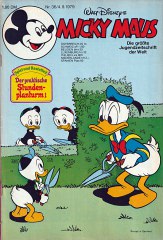Products description
Facsimile of Taliaferro's original drawing for the Donald-Duck-Daily March 3, 1958. Partly masked with foil (used for screening). Original size.
 The Donald Duck Strips by Al Taliaferro are famous for their short, concise wit. No other artist managed to capture a brilliant gag in three to four pictures a day - with few words, often even without any text! Of the few surviving prints Edition 313 chose one Daily from each of Taliaferro’s six years of work in an exclusive series and reproduced it in a 1:1 format on authentic cardboard.
The Donald Duck Strips by Al Taliaferro are famous for their short, concise wit. No other artist managed to capture a brilliant gag in three to four pictures a day - with few words, often even without any text! Of the few surviving prints Edition 313 chose one Daily from each of Taliaferro’s six years of work in an exclusive series and reproduced it in a 1:1 format on authentic cardboard.In order to reproduce the originals faithfully, special processes were used, of which 5-colour printing and foil lamination give the Faksimiles of Edition 313 their unique character.
5-colour printing
- c
- m
- y
- k
- 5
Foil lamination Taliaferro applied foil printed with a halftone screen to the areas that were to appear 'grey' in newspaper printing. In addition to those completely printed with halftone, he also had half printed films at his disposal. This made it possible for him to cut and assemble even the smallest areas. He simply took a larger piece of which the required area had the grid and the rest was transhy;parent. In newspaper reproduction, only the screen areas were captured, while the transparent film remained invisible. By reducing the original 50cm wide drawing to newspaper width for printing, the halftones in the print appeared as a relatively closed grey area.
For the facsimile post-printing of the print templates for which Taliaferro had worked with these screens ("Art Exhibit", "Car Wash", "Staircase", "Two Additional Prints"), the film snippets present on the original were individually captured and masked on a separate film. This made it possible for the film sections to be mechanically laminated to the print on the masked surfaces with hot foil embossing in accordance with the original.
Without passepartout. Special price! Shipping: slightly rolled.
- No frame
- 5-colour printing
- Foil lamination
According to § 19 UStG., we charge no sales tax
modified eCommerce Shopsoftware © 2009-2025
modified eCommerce Shopsoftware © 2009-2025



 Contact
Contact





